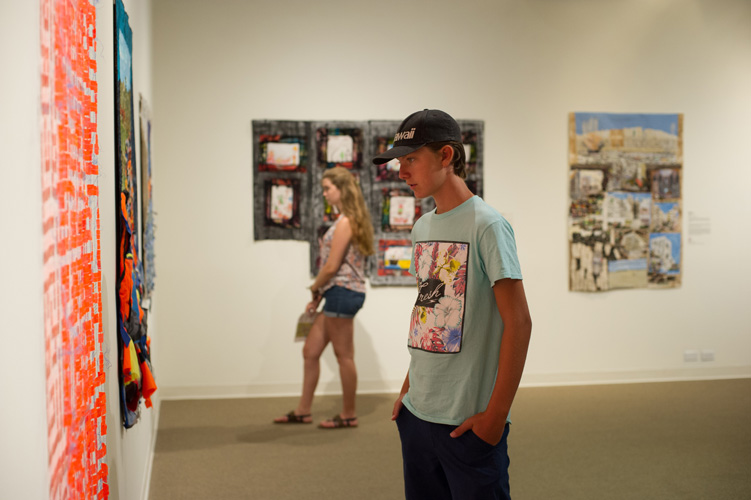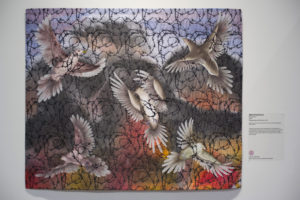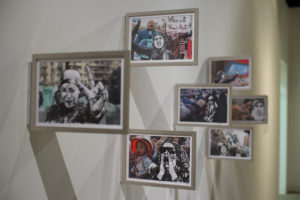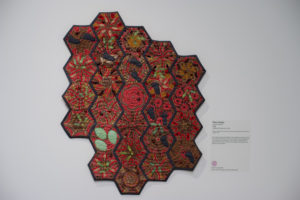
A thought-provoking traveling art quilt exhibition from Studio Art Quilt Associates is on display now through Aug. 24 at Florida Institute of Technology’s Ruth Funk Center for Textile Arts in Melbourne. Titled Forced to Flee, the show takes up two-thirds of the Center’s gallery, with an unrelated solo show by Viennese artist Tanja Boukal occupying the remaining third.
 Forced to Flee opened with a crowded gallery talk by its curator, Susan Beryl Marks, Ph.D., an art historian who specializes in the techniques and ideas behind contemporary quilt making. Marks selected the 36 works in the current exhibition from about 200 submitted to her by SAQA’s world-wide membership.
Forced to Flee opened with a crowded gallery talk by its curator, Susan Beryl Marks, Ph.D., an art historian who specializes in the techniques and ideas behind contemporary quilt making. Marks selected the 36 works in the current exhibition from about 200 submitted to her by SAQA’s world-wide membership.
Opening her remarks with a confession, she notes, “I could have curated a second exhibition from those that did not make the cut this time. It was really, really hard to make those choices; and very emotional.”
That last comment refers to the show’s theme. Forced to Flee addresses the plight of refugees, including the dangerous routes and means by which they escape, and the perils from which they flee.
All of the art in this show comes from first-world nations: France, Germany, Switzerland, the United Kingdom, Ireland, Japan, South Korea, Australia and the United States. All of them receive thousands of requests for asylum every year, just a fraction of which are granted.
Wealthy countries are not alone in trying to deal with the crush of people yearning for a better life. In her essay for the exhibition’s catalog, Marks points out that the refugee crisis has especially strained the social, economic and political structures of poor and developing host countries.
The aim of Forced to Flee, she says, is to present artistic images of the crisis that will etch themselves into the memories of those who view them.
“To get into the show, an artwork had to get me where I live. As an artist, I was interested in the design, techniques and execution of a piece. But all of those things had to come together as a vision and a feeling that affected the viewer.”
For many of us, the word “quilt” evokes a folksy bed cover, tea cozy or other useful what-have-you, composed of a multicolored top layer of pieced fabric, a middle layer of batting and a bottom (or back) layer of plain fabric, sewn through with an all-over pattern of stitches.
“And there’s nothing wrong with that,” says Marks. “But quilt artists, artists in the textile world, often use their art to address difficult situations.”
The artworks in this exhibition retain elements of traditional quilt making, but you would not dream of cuddling up under them. As defined by SAQA, an art quilt is “a creative visual work that is layered and stitched, or that references this form of stitched layered structure.”
 The purpose of an art quilt is to be displayed and appreciated as a work of fine art, akin to an oil painting or a marble sculpture. The quilts in Forced to Flee are hung on the walls, suspended from the ceiling or, in one instance, placed atop a pedestal.
The purpose of an art quilt is to be displayed and appreciated as a work of fine art, akin to an oil painting or a marble sculpture. The quilts in Forced to Flee are hung on the walls, suspended from the ceiling or, in one instance, placed atop a pedestal.
The latter is an artwork from Margaret L. Abramshe of St. George, Utah. Her “Roadmap” provides a look at the route many refugees take to the U.S. from Honduras, Ecuador, Guatemala and Mexico. Its size and format will be familiar to anyone who has ever had a stash of maps in a driver’s side door pocket. Measuring 14 inches high and 49 inches wide, the accordion-pleated art quilt stands open to present both front and back to inspection.
In colorful paints, dyes, thread and photo transfers on cotton fabric, Abramshe tells the story of the brutal conditions under which the migrants travel, and the uncertain welcome they receive at the U.S. border. The front of the artwork includes excerpts from the poem “Borderbus” by the 2015 Poet Laureate of the United States, Juan Felipe Herrera. The back cover reproduces tweets from President Trump.
To tell their complex stories, the show’s artists used a multiplicity of materials, everything from the expected (fabrics, thread and sewing notions), to paint, wax, seeds, wire, lifejackets, rubber raft material, plastic bags and construction fencing, among other things. Their varied techniques include painting, drawing, dying, felting, hand stitching, machine embroidery, screen printing, rust dying and scorching.
One-quarter of the quilts on display depict women and children. While all but one of the artists is female, sympathetic identification is not the primary reason for their inclusion. Women and children are often the most vulnerable of refugees; the ones most likely to be targets of crime or exploitation during their journey. The dangers from which they flee, however, must make the rigors of travel seem worth it.
In her work titled “Amnesty,” Carol J. Vinick of West Hartford, Conn., contrasts Fauziya Kassindja’s carefree childhood in Togo, Africa, with the year-long detention the 17-year-old endured after arriving in the U.S. Her crime? Escaping the ritual genital cutting and enforced marriage to an older man that awaited her coming of age in Togo. Kassindja eventually won her bid for asylum in the U.S.
The top part of Vinick’s composition shows dancing children limned in colorful appliqué. Underneath that scene, drab brown and black fabrics depict the bars and watchtower of a prison.
Other quilts attest that male and female, young and old, are all one when ethnic violence pits one people against another, or when depraved governments decree the deportation or mass murder of millions of citizens.
 Christine Vinh of Arlington, Va., is represented by “Forty Years after the Zero Years,” her remembrance of Cambodia’s reign of terror under the Khmer Rouge in the 1970s. It is composed of collaged, stenciled and photo transferred-imagery on fragments of burlap; these are appliqued onto a pieced background of dark-colored and rust-stained fabrics.
Christine Vinh of Arlington, Va., is represented by “Forty Years after the Zero Years,” her remembrance of Cambodia’s reign of terror under the Khmer Rouge in the 1970s. It is composed of collaged, stenciled and photo transferred-imagery on fragments of burlap; these are appliqued onto a pieced background of dark-colored and rust-stained fabrics.
Harriet Cherry Cheney of Dobbs Ferry, N.Y., presents “Pogrom,” a colorful confection of fabric, yarn, plastic tubing, beads and feathers that, at first glance, looks like an innocent tangle of stuffed toys. A closer look reveals a brutal, mustachioed face near the composition’s center that lords over the confusion around him: depictions of burning houses, bloody limbs, screaming mouths, a naked breast and a curl of intestine. In this context, a gore-covered toy knife jutting from the carnage at lower right seems all too real.
A few of the art quilts in Forced to Flee address environmental disasters that make refugees not only of people but of animals, too. These include the loss of homes and habitat from the massive fires, years-long droughts, rising tides and monster storms associated with a world-wide climb in earth’s temperature.
Global warming was addressed in one of the very few non-representational works in the exhibition. “Scorched Earth” by Pamela S. Burns of Martinsville, Ind., features a hand-dyed and reverse-appliquéd background material that suggests a forest of saplings lit from behind by amber fire. Atop this, a crust of scorched material lies like a pall.
In the accompanying label for the piece, Burns notes that she was inspired by wildfires in the U.S. that, between January and October 2018, laid waste to 8.1 million acres of land.
She wrote, “Trying to scorch some cheesecloth for this piece, I immediately had an out-of-control fire in my sink and needed help to extinguish it. How quickly these fires can start and spread became evident.”
A fully illustrated catalog published by SAQA for the show is available for purchase at the Ruth Funk Center’s gift shop. For more information, visit textiles.fit.edu.



